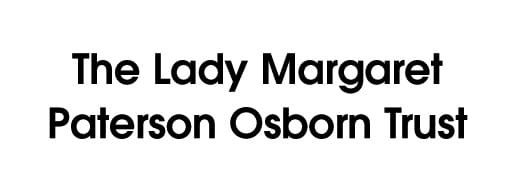Northstowe
A multi-phase large scale new community in Cambridgeshire
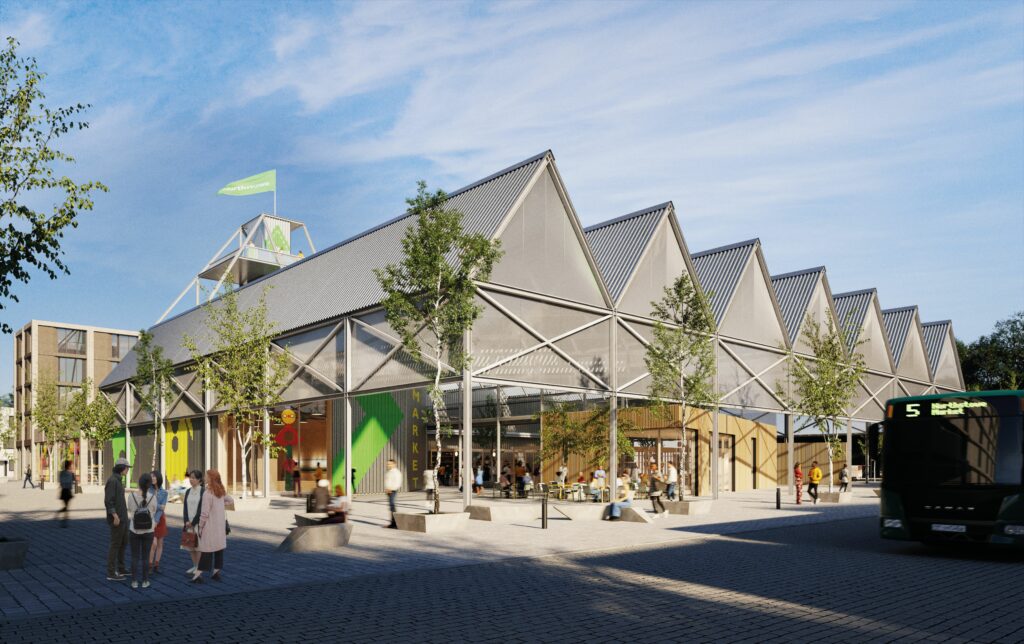
- Location: Cambridgeshire
- Size: 10,000 homes
Northstowe is a new town being built on the former Oakington RAF base and surrounding land. It is located 8 miles north-west of Cambridge City Centre and is directly connected to the city and surrounding settlements via an operational Guided Busway to its eastern boundary. When completed, Northstowe will comprise 10,000 new homes, 8 new schools, plus a wide range sports facilities, community facilities, open spaces, and sustainable transport measures – with aim of the construction of the New Town to be finished by 2042. The first occupants moved into properties on Phase 1 in May 2017, and this phase is almost fully built and occupied. When complete it will be the largest new town built since Milton Keynes.
There are unique arrangements with two master developers for the town’s creation, L&Q (Phase 1) and Homes England (Phases 2, 3A and 3B).
Northstowe Phase 1 (L&Q)
L&Q is responsible for Phase 1 of Northstowe including 1,500 homes, primary school and associated public realm.
Greenbelt were appointed by L&Q in 2016 to structure the costs and manage the land for Phase 1 at Northstowe, however the contract was not concluded until 2019, due to the time taken for the Section 106 agreements to be agreed with all the stakeholders. The handover of stewardship from the developer to the managing entity has been planned by the council, who have invested in dedicated council liaison officers based on site to oversee the public realm and space issues. The handover of information from the developer to the management entity is robust and consistent, as within the Section 106 there is a management and maintenance specification and embedded ‘user manuals’ for public open space, including landscape plans/SUD facilities.
South Cambridgeshire District Council has been proactive to ensure the development was implemented and thus managed well and overseeing the implementation of the new town council, to operate and assume the responsibilities of the council currently. The management of the public open spaces, sustainable urban drainage systems (SUDS) and sports facilities are reviewed through monthly steering groups, attended by all the stakeholders involved in the development of these assets.
Phase 2 (Homes England)
For Phase 2, 3A and 3B the arrangements will take a different approach. With Homes England as the master developer, there is long-term ownership of the site established and, therefore, known continuity for partners and those living here. Homes England is delivering the remaining two phases of the Town including the Town Centre and all associated infrastructure with a predicted overall population of up to 50,000 people. Phase 2 currently has an operating secondary school, two amenity lakes and 43 homes constructed with occupations and a second housebuilder onsite.
The Phase 2 Section 106 agreement contains certain obligations around community asset land transfer in the medium to long term. It has detailed planning consent for certain infrastructure works and detailed planning for the initial sub-phase disposals to development partners. Phase 3a and Phase 3b have recently achieved planning consent (2022) so are less advanced than Phase 2, design codes and other strategy documents are yet to be produced, there are no detailed consents and disposal activity has not commenced.
Under the signed section 106 agreements several facilities are to be transferred to local authorities, some of this involves initial construction activity whilst some is supported by s106 financial contributions. This will include Schools, Sports Pitches and Faith Spaces. Ultimately this land will be transferred out of Homes England’s responsibility, therefore not part of long-term stewardship arrangements. In addition to the above there is a requirement under the section 106 agreements to explore transfer of assets to Northstowe Town Council.
In the short-term Homes England will be responsible for significant areas prior to transfer/development or adoption. A separate estate management strategy is in place for this period.
Northstowe Phases 2, 3A and 3B lead by Homes England are currently in the early stages of exploring their stewardship arrangements, and progression of this will be lead with the planning requirements at the forefront as well as extensive consultation with local stakeholders and the community for the long term success of Northstowe Town as it grows.
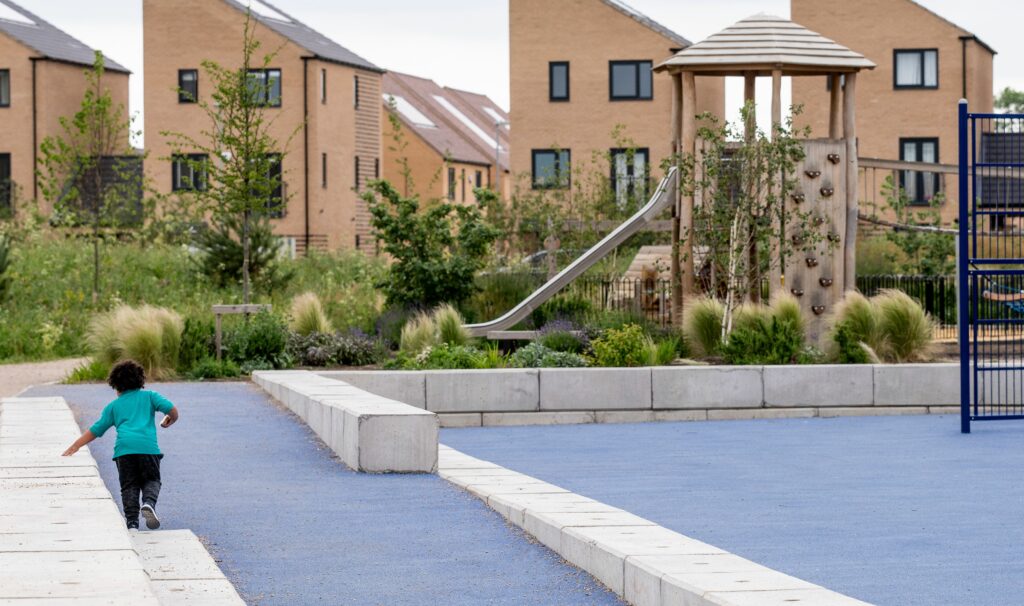
Beaulieu
Developer initiated greenspace stewardship by the Land Trust

- Location: Chelmsford
- Size: 3600 homes
At their Beaulieu development, developers Countryside and L&Q recognised the benefits of a long-term perspective on stewardship and made an early commitment to ensure that the open space on the site was transferred to a not-for-profit organisation to undertake stewardship of the site. The organisation identified would also support the community development aspects of creating a new community. The developers were also keen to have an organisation that would be happy to take on the management of assets which were not yet adopted.
The developers progressed stewardship arrangements independent of the local authority, noting that being given the space to progress made the process easier. The Section 106 agreement for the site established that a service charge would be levied on residents to pay for the open space maintenance, as well as for the community centre and health centre on the site.
The Land Trust was appointed to take on the long-term ownership and management of the green infrastructure on the site. By the end of the 20-year build-out, the Land Trust will manage the 72 hectares of parks and open spaces incorporated into the original masterplan. As the development progresses, the open space is being transferred in phases to Beaulieu Estate Management Ltd, a wholly owned subsidiary of the Land Trust.
The Land Trust will take care of the estate parkland indefinitely on behalf of, and in partnership with, the Beaulieu residents and the wider local community, through the collection and administration of a service charge. The Land Trust is encouraging residents to engage by:
– providing feedback and views
– establishing a ‘friends’ group
– running community events
– helping to shape how green spaces are maintained and used
Emerging lessons from Beaulieu Park:
- Start your thought process early
- Aim for a coherent approach across the whole site
- Be site specific rather than seeking to implement a standard approach
- Long-term quality and durability are vital to scheme success
- Ensure integrated landscape design with public open space and green infrastructure are provided throughout the development
- The right design and stewardship can improve public health and wellbeing
- The right stewardship approach provides community engagement opportunities
For the full case study please click here
South of Ashford Garden Community: Chilmington Green
Setting up a council driven community management organisation
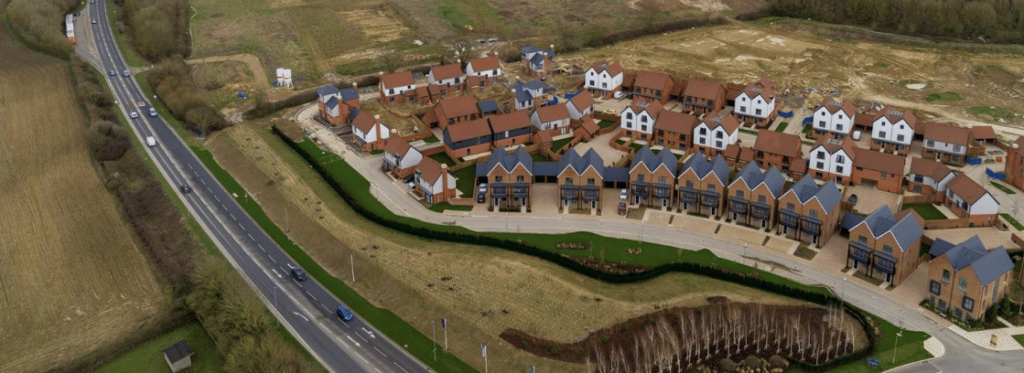
- Location: Chilmington Green, Court Lodge, Kingsnorth Green.
- Size: 7,250 homes (2,175 affordable)
Chilimington Green is part of Homes England Garden Communities programme. By December 2020, roughly 50% of phase 1 (1,501 homes) had reserved matters permission and over 58 dwellings were occupied. Outline planning applications have been submitted for Court Lodge and Kingsnorth Green. To manage the assets of the new community, Chilmington Management Organisation (CMO) was set up by Ashford Borough Council and Hodson Developments to own, manage and maintain the community spaces and buildings. Its focus is to foster a community focus on stewardship and secure long-term financial stability.
The long-term stewardship of assets was a principle set in the Chilmington Green Area Action Plan. The Section 106 Heads of Terms defines the requirements for bringing forward the stewardship model. To set it up, the local authority invested resources to bring forward CMO in partnership with developers, recognising the holistic value that a stewardship body would bring to the council in the long-term.
Funding
Assets are endowed to the stewardship body, including community buildings, open spaces, play spaces and allotments.
Forms of income include:
- Grant and a deficit grant which help cash flow in the early years, and from endowed commercial assets.
- Early support funding is crucial, as specialist advice and support costs are often underestimated.
- A resident charge to support the running costs of CMO and its activities. There are three different rent charge deeds:
Deed 1)
annual estate charge, divided into different bands proportional to the number of bedrooms in each house.
Deed 2)
allow for an increase in Deed 1’s rent charge, by up to 20% after 2030 with CMO Members agreement and sets out some additional obligations that the CMO will undertake.
Deed 3)
is applicable to areas of the estate such as private courtyards, which are only paid by the residents where it applies
Governance and a common vision
The first community building run by CMO and use of Section 106 sums for community development, will promote community engagement and the building will provide income for the management organisation. It is a modular building that could be relocated as the development progresses. It also provides workspace for CMO staff, a bookable meeting room and community room for public use. Governance and a common vision demonstrate that stewardship should be considered a corporate issue for the council.
A vision for stewardship should be agreed by all partners from the start. Having the principle of stewardship in the Area Action Plan, put the local authority in a good position to ensure that developers understood what the requirements were. The local authority appointed a specialist lawyer to support Section 106 negotiations with developers, to agree on the governance of CMO and other aspects of the stewardship model. The board of trustees who make the strategic decisions have nominated representatives from:
- developers (up to five nominations)
- local authority (two nominations)
- voluntary sector (one nomination)
- a housing association (one nomination)
- a resident (one nomination in phase one)
Throughout construction, developers have up to 50% of the votes at the board, with the other parties holding the other 50%, but once the last house is sold, the developers vacate their board positions and residents take over. To increase resident representation, a further four residents will be appointed, one for each phase.
Emerging lessons from Ashford Garden Community:
- Make a corporate commitment to stewardship
- Appoint an interim body, led by developer but with council, parish and wider community input
- Secure a strong vision for the stewardship body early on with all partners
- Think beyond the planning and construction phase
- Keep matters simple, wherever possible
- Early cash flow is essential
- Community engagement and involvement is key
- Be flexible
Ebbsfleet Garden City Trust
Urban Development Corporation initiated stewardship arrangements.
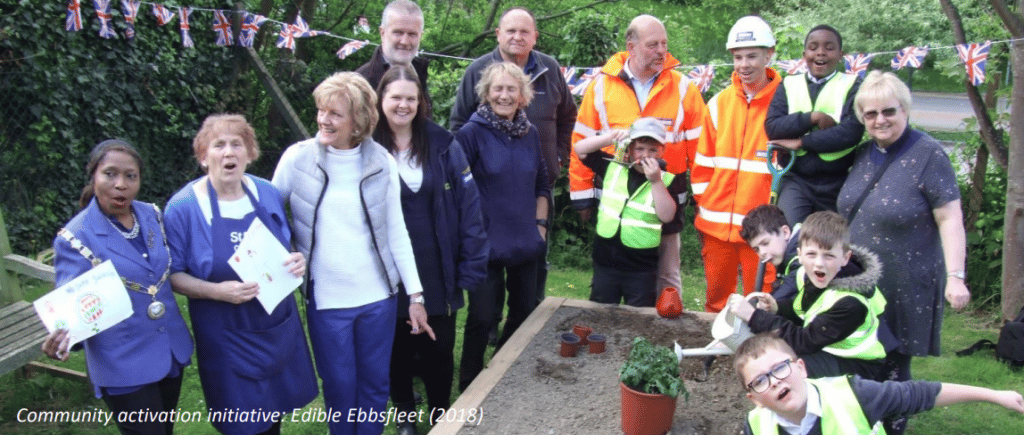
- Location: North Kent
- Size: 15,000 new homes
In 2015 the Government established the Ebbsfleet Development Corporation (EDC), EDC is an Urban Development Corporation, whose activities and finances are controlled by what is now called the Government Department for Levelling Up, Housing and Communities (DLUHC) and, ultimately, HM Treasury.
While the circumstances in Ebbsfleet GC are unusual, EDC’s work on a stewardship strategy provides valuable transferable lessons for other new community projects where the site includes existing planning permissions, management companies, and a variety of community assets and funding mechanisms coming forward. The EDC has been working for several years to develop a stewardship solution for the future maintenance of Ebbsfleet GC parks, open spaces and community buildings, alongside ongoing programmes of placemaking and community development activities.
The existing planning consents covered much of the land within the EDC’s boundary, but many of these consents were old, did not include provision for effective stewardship arrangements and could not be unilaterally re-opened to correct this. As a result, many developers in the Ebbsfleet GC area have resorted to funding long-term management of public open spaces, sports facilities, play parks, and neighbourhood community buildings through service charge regimes, whereby residents of the new developments are charged for the management of facilities that will be open and accessible to the public, without restriction.
EDC’s work to develop a solution has been complex, and has involved detailed discussions with developers, local authorities, DLUHC’s policy, finance and commercial teams, and also with HM Treasury. Recognising the importance of committing to a framework to guide detailed stewardship arrangements, the EDC board agreed some key principles to guide the stewardship strategy.
- Scope
- Form and operations
- Funding
See Heart of the Matter case study for more
The Ebbsfleet Garden City Trust (EGCT) will be responsible for the long-term maintenance of the parks, public open spaces and community facilities, as well as engaging and building community through encouraging and enabling civic life and recreational activities. It will be the charitable legacy and stewardship organisation when EDC completes its work. In 2021 EGCT was set up as an independent charity with its own board of trustees, made up of residents and key stakeholders. From 2022 onwards, community allotments, buildings and large parks will be transferred to EGCT to be managed and maintained, along with income generating assets to meet any net costs and liabilities. EGCT also intends to work with the residents, house builders and managing agents, to ensure consistent high maintenance standards across the Garden City, at affordable rates for residents. This might require taking responsibility for the Estate Management Companies or acting as the managing agent. The proposal is built upon a model whereby community assets that require future management across the Garden City fall into three broad categories:
A) Local neighbourhood assets (for example, small scale children’s play areas, small scale landscaping or similar) that will be provided by developers through Section 106 and which will 45 be fully funded through service charges
B) Garden City scale assets – provided by developers through existing Section 106
C) Garden City scale assets – not provided by developers through Section 106, which EDC expect to bring forward and directly deliver in line with its mission to deliver the Garden City. Assets in category (A), will continue to be funded through service charges levied on new residents. Most of these assets are the responsibility of existing management companies set up by the developers. Assets within categories (B) and (C) are the strategic assets which EDC wish to see funded through means other than service charges, i.e. through earned income from letting and management of facilities and endowment income.
The proposed structure for the Trust at the end of the EDC’s life is set out below:
- Trustees will include representatives of local residents, local businesses, the (former) EDC, local authorities Social Landlord (Housing Association) and Voluntary/Community/Faith sector and Ebbsfleet Design Forum.
- A key feature of the EGCT model is that of the ‘guardianship group’ – an unincorporated, inclusive stakeholder group created to oversee, monitor and advise the work of the stewardship trust but without any executive powers or functions.
- It is intended that this will be set up during 2022
Emerging lessons from Ebbsfleet:
• Retrofitting stewardship arrangements is complex
• Think about categories of assets requiring stewardship
• Commit to core principles as a framework for details
• Link governance and community engagement
• A stewardship body which is established with a robust and transparent governance framework and financial model, can demonstrate how it would provide higher quality maintenance.
Bournville Village Trust
Whole-place stewardship in model village and new communities

- Location: Midlands
- Size: 8,000 homes
Bournville Village Trust (BVT) is one of the longest-established not-for-profit housing associations in the UK, providing social rented housing, BVT manages supported housing, commercial activities, community facilities, parks and open spaces and agricultural estate.
It is one of a small handful of long-established stewardship organisations that have taken a ‘whole place’ approach to stewardship in the management of their historic estate and in the creation of new communities on its development sites. Details of BVT’s stewardship arrangements are set out on their website and those for Lightmoor and Lawley are in case study 2 in Built Today, Treasured Tomorrow (TCPA, 2014) and in TCPA’s Guide to Long-term stewardship (2016), Section 6.1.
In 2019, BVT began a strategic review of its operations. Some initial findings are set out in its 2020 Annual Report 37, including the intention to undertake a more detailed review of its stewardship operations in 2021. Some of these findings are relevant to other places.
BVT is also currently reviewing its design guide in Birmingham to create ‘a new Bournville Estate Design Guide fit for the 21st century and Lightmoor and Lawley each have their own pages (https://www.lightmoorvillage.org.uk/ and https://www.bvtlawleyvillage.org.uk/ ).
For BVT: https://www.bvt.org.uk/home-owners/bvt-responsibilities/ Annual Report 2020 (Bournville Village Trust, 2020). Accessed at: https://www.bvt.org.uk/publications/annual-report-2020/28
On its Birmingham estate, a fixed rate model for service charges was established in 2001. This model was designed to provide residents with reassurance that service rates would not increase beyond levels they could afford. Twenty years on, the costs of maintenance have increased significantly. Maintaining services to the high standards specified in the Estate Management Scheme now costs more annually than the fees collected for the service. This poses a financial challenge for the Trust, but at the same time BVT notes that it forces the stewardship body to ensure best value for money.
Emerging Lessons from Bournville Village Trust:
• Don’t lose sight of the vision
• Emotional connection to place and stewardship is important. Show you care.
• Ensure fairness, quality and a long-term consideration of cost when considering service charges
• Partnership and collaboration with delivery partners is essential
• Ongoing communication with residents important
• Residents must feel that governance is accountable and responsive
• Review services and operations periodically
The Parks Trust, Milton Keynes
Managing growth and green infrastructure in the UK’s fastest growing new city
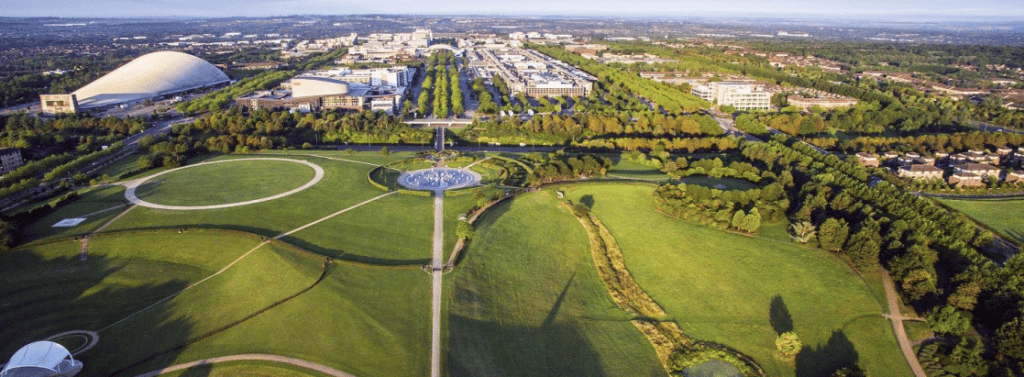
The Parks Trust in Milton Keynes is a registered charity set up in 1992 to care for the city’s green space and ensure it would be managed and protected forever, without having to compete with other council priorities for funds.
It granted 999-year leases over the parkland, with the freehold going to the Council, and endowed with a commercial property portfolio, the value of which equated to the liability cost of maintaining the parkland
Over time, the Trust has diversified and grown its endowment portfolio, providing a sustainable source of income for its work. The Trust is self-financing, managing over 6,000 acres of green infrastructure including linear parks, woodlands, lakesides and landscaped areas alongside the city’s main roads – about 25% of the new city area. As the city continues to grow, new parks and open spaces are being transferred to the Trust with endowments.
The endowment sums are based on calculations of the maintenance costs for each site, multiplied by a factor to derive the capital sum needed to invest to generate the income to cover the maintenance costs in perpetuity.
The income from the developments can only be used towards Trust’s charitable purposes and has enabled the provision of enhanced parkland facilities and the purchase of additional land of high environmental value to add to the Trust’s parkland network.
Key Lessons from recent activities at Milton Keynes Parks Trust
• Detailing stewardship requirements in the Local Plan policies is possible.
• A strategic vision for stewardship beyond a specific site can improve resilience over time
• Secure the skills to ensure high standards of delivery
• Ensure a diverse income and investment portfolio
• Commit to a strong vision
Graylingwell Park – Chichester Community Development Trust
A new development with high quality community assets at its heart
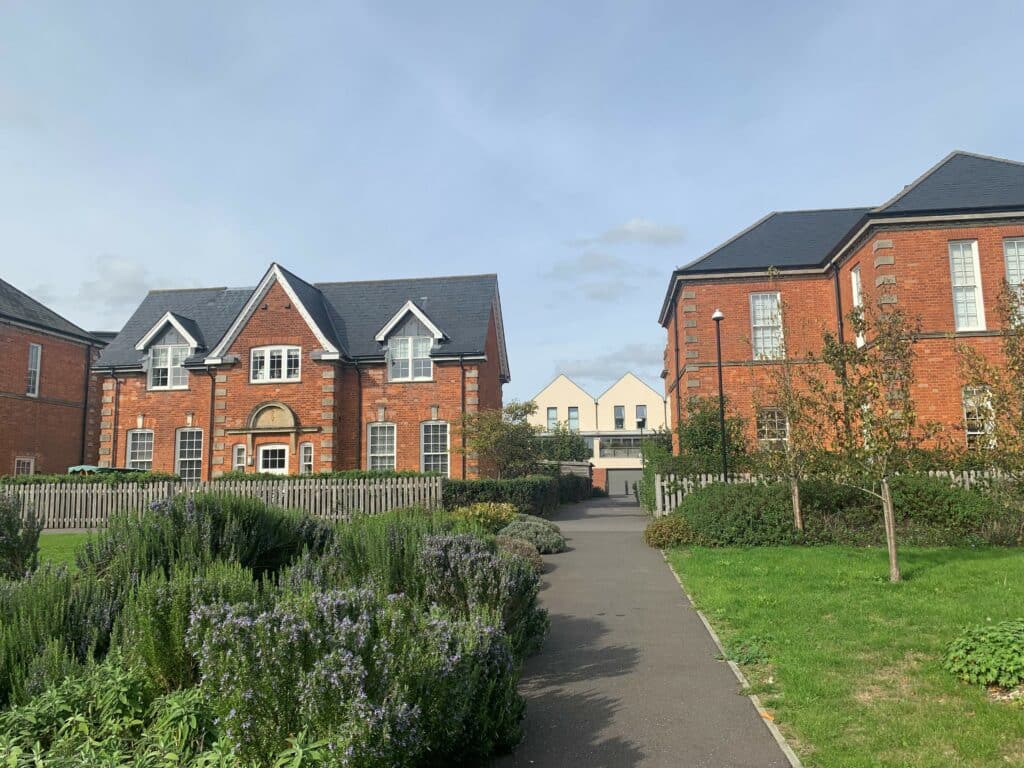
- Location: Chichester, West Sussex
- Size: 750 homes
Chichester Community Development Trust (CCDT) was established in 2009 to represent the needs of the community when the site of Graylingwell Hospital was sold to Linden Homes and Affinity Sutton. Following the sale of the site, demolition and conversation work began in 2010 to turn the site into a carbon-neutral community Graylingwell Park. The development was led by CCDT and planned through an extensive community planning process with a consensus-led approach to design. Thanks to success in the initial stages, CCDT got involved in representing the new community at Roussillon Park in 2010 and at neighbouring Keepers Green in 2019. Since then, they have ensured the successful completion of numerous community buildings and delivered many community development projects, events and activities in the wider community.
Graylingwell Park is a 34ha site, which used to house a hospital. It is both a registered historic park and garden and has been designated as a Conservation area, within which lies two Grade II listed buildings, 472 protected trees and a scheduled monument.
Considered to be the largest carbon neutral development in the UK, it has 750 new homes, a primary school and a large array of community and commercial spaces. It is one of the first commissioned community-wide Combined Heat and Power Plants, providing 90% of heating to the development, including an 8km district heating pipe network.
CCDT works with developers to identify assets that can be bought into community ownership rather than sitting with management companies. The Trust has a variety of assets (see Fig. 1) that generate surplus. This surplus is then reinvested in the local community through free or affordable activities to encourage the community to come together. In 2020, 21% of their income was made through trading from room hire and events. Furthermore, the households pay a resident levy of £50 per household, which is currently 750 homes. The rest of the funding for the Trust comes from grant income, Section 106 contributions and events and activity income. The Trust have developed and continue to own and manage community buildings and land within Chichester, reserving and safeguarding these for use by the community. If any profits are generated by these, CCDT ensures they go back into funding more projects for the community:
Graylingwell Chapel – has been turned into a community space, including facilities for performances, events, meeting and learning rooms, children’s play area, open to the community 9-4pm Monday to Saturday.
The Pavilion – is a space for fitness and wellbeing, that was designed around the needs of the Chichester Community after an extensive study, including a studio, therapy room and a café.
The Studios – These are soon to be refurbished stables to provide spaces for individuals and businesses to rent, with WIFI, workstations, a breakout area, meeting rooms and access to printers/photocopiers.
The Water Tower – a unique double storey space, available to hire and suitable for functions, networking events, workshops and training.
Community Garden – A garden that is open to all residents of Roussillon Park, Graylingwell Park and Keepers Green.
The Community Hall – a multi-purpose hall, with kitchen facilities, providing a space for a variety of community activities, such as club meetings, exercise classes, music/drama rehearsal spaces, exhibitions and receptions.
Otterpool Park LLP
Delivering a new garden town to support sustainable living and a healthy economy
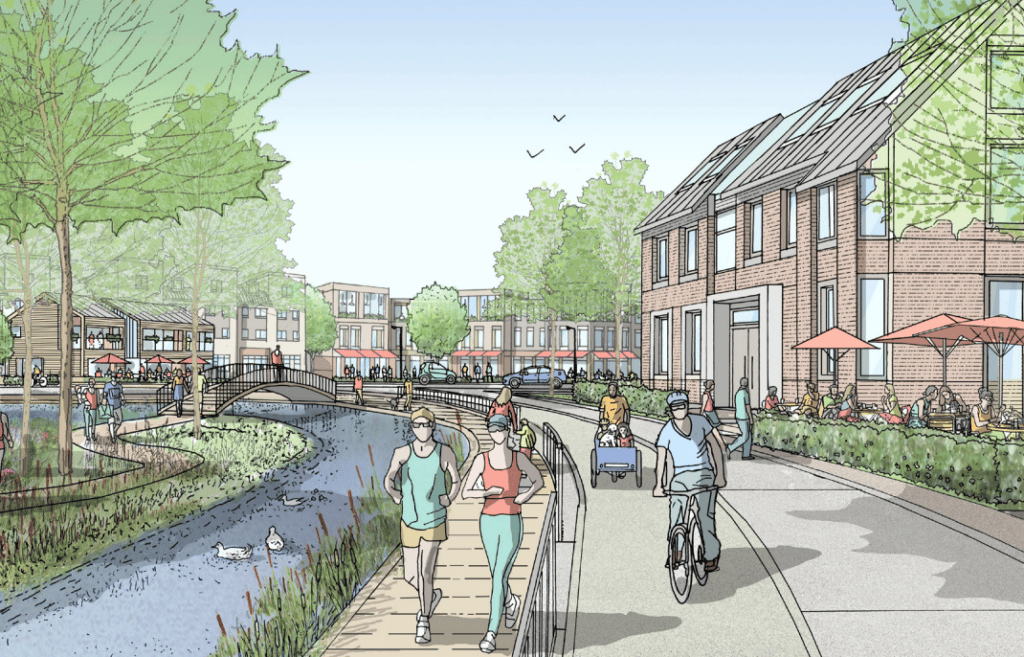
- Location: Between Folkstone and Ashford, Kent
- Size: 10,000 homes
Otterpool Park is a proposed new Garden town in Kent, to be developed by a local housing company founded by Folkestone and Hythe District Council. 10,000 homes are proposed, with 6 schools, a community hub and shops, with the aim to create 9,000 new jobs.
The aim is the Otterpool Park LLP will responsibility of the cultural assets of the development. The plan for the ongoing management of community and public spaces is likely to be a community-led body, to allow future residents and businesses to decide and control this.
The ongoing management of Otterpool’s public and community spaces is likely to be the responsibility of a single, community-led body, allowing future residents and businesses to influence the design and ongoing management of community facilities. Their work will be critical to maintaining and building on the quality of the development, so it is recommended that the management and use of cultural assets is included in the remit of this new body.
The plans suggest a long-term stewardship strategy shall set out how the landscapes and open spaces will be maintained to a high quality for long-term use by the community. There are suggestions that a community trust may be set up with agreement such as that of the Milton Keynes Park Trust.
Chatham Maritime Trust – Medway, Kent
One of the largest historical regeneration schemes in the UK
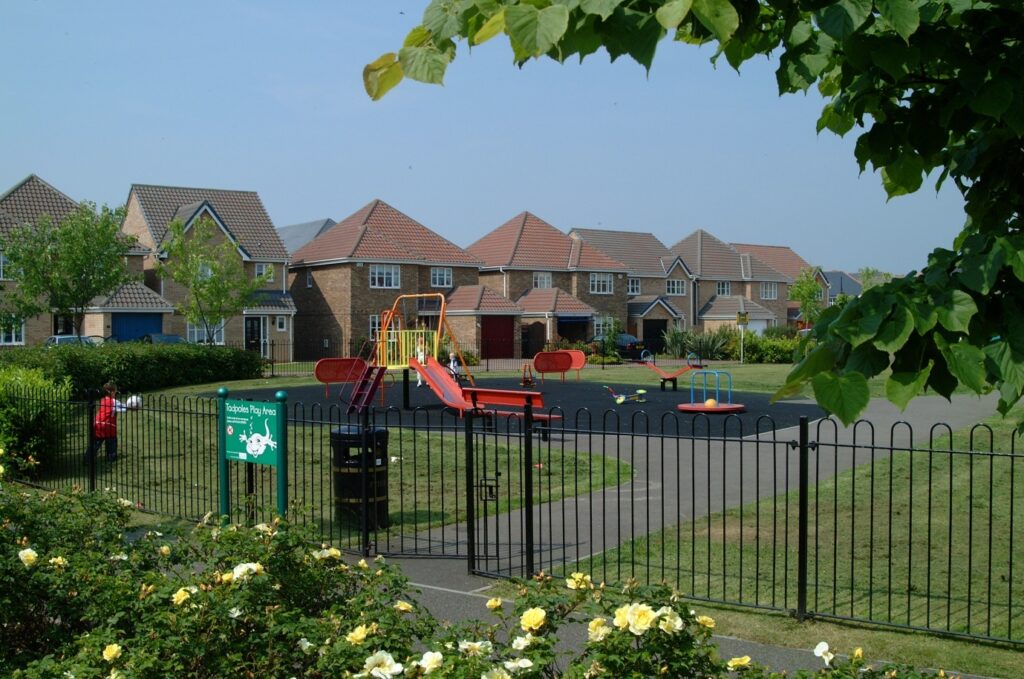
- Location: Medway, Kent
- Size: over 2000 homes
Medway’s dockyard was closed in 1984 and a masterplan for the site was developed by English Partnerships (formerly Urban Regeneration Agency and now Homes England), including infrastructure such as new roads and a tunnel under the Medway, where the south of the site, ‘South of Basins’ was allocated for commercial, educational, leisure and retail developments and the north, St Mary’s Island, for residential use.
However, many areas of Chatham Maritime were not sold freehold; these included river defence walls, open landscaped areas, some service roads, the dock basins, bridges etc. In setting up the long-term strategy, English Partnerships had to consider what to do with these to ensure that they were properly looked after. The solution was to set-up a charitable trust to look after the whole estate and so Chatham Maritime Trust (CMT) was established in 1997 to take on the responsibility for the long-term management and maintenance of the 350-acre Chatham Maritime Estate and will gradually take responsibility of the land as the development is completed. The trust was established by Homes England (then English Partnerships), who facilitated the regeneration and continued development of the site, however once finished, the transfer of ownership to the trust will occur over the next 5 to 10 years.
The trust looks after 4 parks, playgrounds, cycle ways, a riverside walk and other community facilities, as well as the flood defences, two dock basins and a bridge, for the benefit of the community and users of the estate. The trust deals with the day-to-day management of the estate from an office located onsite with a small professional team, that is funded by income from the residents and commercial occupiers, in addition to an endowment to the long-term maintenance of the site’s major infrastructure. This includes: three large parks, a riverside walk, three playa areas, and other open public spaces, as well as flood defences and two large dock basins. The trust is also responsible for St Mary’s Island Community Centre and a water centre, these assets are used to host events and provide opportunities for other organisations to use these spaces. The community fund also supports projects in the Medway Towns and supports the St. Mary’s Island Youth Club.
CMT states that its main objectives are:
• To ensure that the Estate is maintained to a high standard
• Deliver services that provide value for money
• Act as a key partner in Chatham Maritime
• Engage fully with local communities
• Ensure that the Trust is sustainable for the long-term
Cambourne, Cambridgeshire
Cambourne is a vibrant community and it is our intention to enable more residents to play an active role in the community.
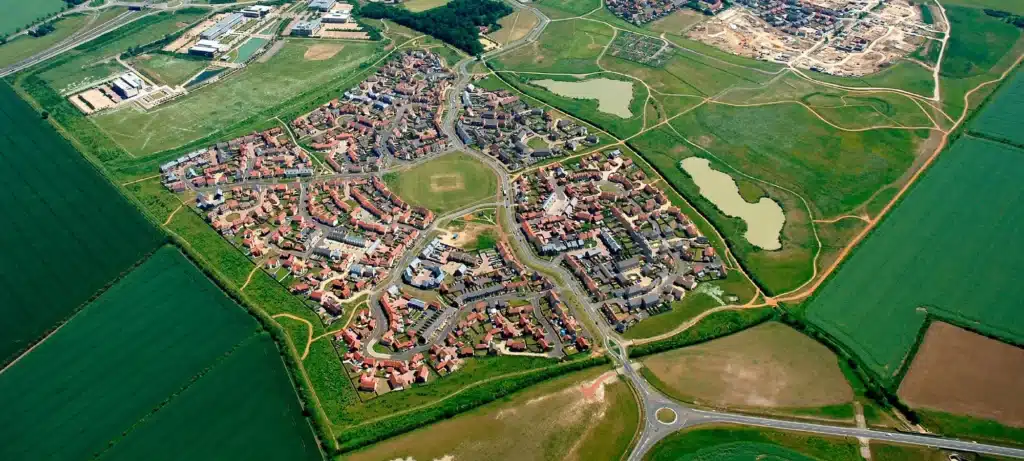
- Size: 3300 houses
- Location: 9 miles west of Cambridge
Cambourne is a new settlement and now the largest town in South Cambridgeshire, where development started on the site in 1998 and the first occupants moved in 1999. The original masterplan for Cambourne set out a vision of 3 interlinked villages, Great Cambourne, Lower Cambourne and Upper Cambourne – each planned around village greens and connected by a central spine road running East to West. It was originally developed by Bryant Homes, Bovis Homes and McAlpine Homes. The successor companies Vistry and Taylor Wimpey are now developing an extension to Cambourne, called West Cambourne, and the first residents moved in last year.
The long-term stewardship of Cambourne is with both Cambourne Town Council and the Wildlife Trust. The Wildlife Trust look after the western country park, woodlands and some elements of open space, while the Town Council look after the eastern country park (originally planned to be a golf course with public footpaths running through it), village greens, greenways, most of the open spaces, allotments, burial ground, verges (for the County Council), sports fields (including 11 football pitches, two cricket pitches, bowls green and playgrounds.
The Town Council will be responsible for the long-term management of all of West Cambourne.
The process for taking on the maintenance of the green infrastructure has developed over the years and has changed following the formation of the Town/Parish Council. The Wildlife Trust were approached to take on the stewardship of the Country Park in exchange for the provision of their headquarters. Since the Town Council was formed and developed its own grounds team (8 grounds Staff), we started maintain the green spaces paid for by the developers until the land is transferred to the Town Council. With the adoption of the roads by the County Council they pay the Town Council to maintain the verges (3 cuts a year) which we maintain to a higher standard. The Town Council work closely with the Wildlife Trust and maintain some of the greenways for them.
With the West Cambourne development Town Council has agreed to take on the maintenance of the green infrastructure after the initial years maintenance period for the landscape contractor has been completed. The maintenance figures and draft transfer document have been built into the s106 to simplify the transfer of the green spaces to the Town Council. The Town Council agreed to a two year commuted sum to ensure management companies were not put in place.
Link to further cases studies from our sponsors Greenbelt:
